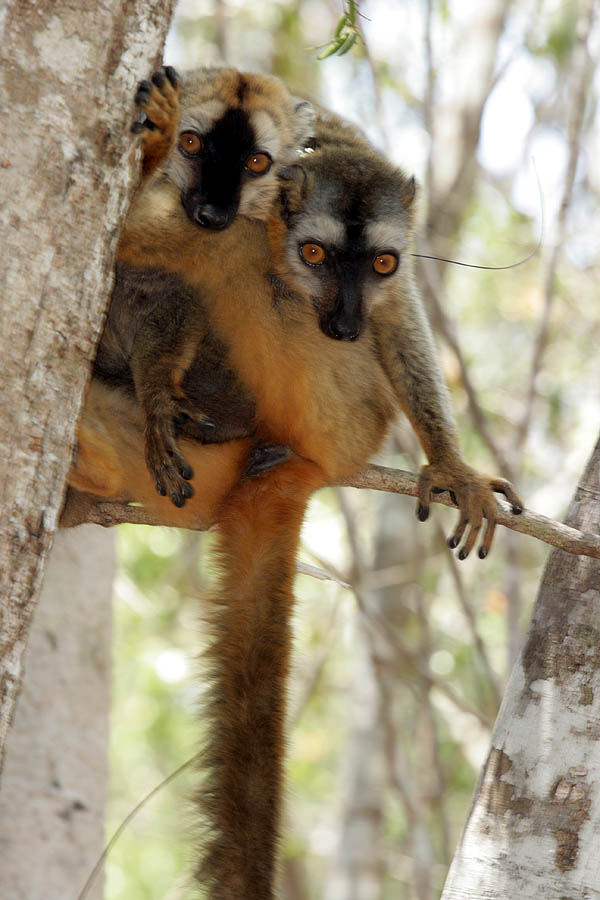- Common Brown Lemur
Taxobox
name = Common Brown LemurMSW3 Groves | pages = 115| id=12100040]

status = NT
status_system = iucn3.1
status_ref = IUCN2008 | assessors = Andrainarivo, C., et al | year = 2008 | id = 8207 | title = Eulemur fulvus | downloaded = 07 October 2008 Listed as Near Threatened (NT v3.1)]
regnum =Animal ia
phylum = Chordata
classis =Mammal ia
ordo =Primate s
familia =Lemuridae
genus = "Eulemur"
species = "E. fulvus"
binomial = "Eulemur fulvus"
binomial_authority = É. Geoffroy, 1796The Common Brown Lemur ("Eulemur fulvus") is a species of
lemur in theLemuridae family. It is found inMadagascar andMayotte .Range
The Common Brown Lemur lives in western Madagascar north of the
Betsiboka River and eastern Madagascar between theMangoro River andTsaratanana , as well as in inland Madagascar connecting the eastern and western ranges.cite book|title=Lemurs of Madagascar|edition=Second Edition|author=Russell Mittermeier et al|page=272-274|year=2006|isbn=1-881173-88-7] They also live on the island of Mayotte, although this population is believed to have been introduced there by man.Physical description
The Common Brown Lemur has a total length of 84 to 101
centimeter s, including 41 to 51 centimeters of tail.cite book|title=Mammals of Madagascar|author=Nick Garbutt|page=155-156|year=2007|isbn=978-0-300-12550-4] Weight ranges from 2 to 3kilogram s. The short, densefur is primarily brown or grey-brown. The face, muzzle and crown are dark grey or black with paler eyebrow patches, and the eyes are orange-red.Similar lemur species within their range include the
Mongoose Lemur , "E. mongoz", in the west and theRed-bellied Lemur , "E. rubriventer", in the east. They can be distinguished from these species by the fact that "E. mongoz" is more of a grey color and "E. rubriventer" is more reddish. There is also some overlap with theBlack Lemur in northeast Madagascar in the Galoko, Manongarivo and Tsaratanana Massifs.cite book|title=Lemurs of Madagascar|edition=Second Edition|author=Russell Mittermeier et al|page=288|year=2006|isbn=1-881173-88-7] There is also overlap and hybridization with theWhite-fronted Brown Lemur , "E. albifrons", in the northeast portion of the Common Brown Lemur's range.cite book|title=Lemurs of Madagascar|edition=Second Edition|author=Russell Mittermeier et al|page=282|year=2006|isbn=1-881173-88-7]Diet
The Common Brown Lemur's diet consists primarily of fruits, young leaves, and flowers. In some locations it eats invertebrates, such as
cicada s,spider s andmillipede s.cite book|title=The Pictorial Guide to the Living Primates|author=Noel Rowe|page=40|year=1996|isbn=0-9648825-0-7] It also eats bark, sap, soil and red clay (seegeophagy ). It can tolerate greater levels of toxic compounds from plants than otherprosimian s can.Behavior
Consistent with its large range, the Common Brown Lemur occupies a variety of forest types, including lowland
rainforest s,montane rainforests, moistevergreen forest s and drydeciduous forest s. They spend about 95% of their time in upper layers of the forest and less than 2% of their time on the ground.They normally live in groups of 5 to 12, but group size can be larger, especially on Mayotte. Groups occupy home ranges of 1 to 9
hectare s in the west, but more than 20 hectares in the east.cite book|title=Primates in Perspective | chapter = Lemuriformes | author = Lisa Gould and Michelle Sauther | editor = Christina J. Campbell, Agustin Fuentes, Katherine C. MacKinnon, Melissa Panger and Simon K. Bearder|year=2007|page=53|isbn=978-0-19-517133-4] Groups include members of both sexes, including juveniles, and there are no discernable dominance hierarchies.They are primarily active during the day, but activity can continue into the night, especially during full moons and during the dry season.cite book|title=Primate Ecology and Social Structure Volume 1: Lorises, Lemurs and Tarsiers|author=Robert W. Sussman|page=186-187|year=1999|isbn=0-536-02256-9]
In the western part of its range, the Common Brown Lemur overlaps that of the
Mongoose Lemur , and the two species sometimes travel together. In the areas of overlap, the two species also adapt their activity patterns to avoid conflict. For example, the Mongoose Lemur can become primarilynocturnal during the dry season in the areas of overlap.Reproduction
The Common Brown Lemur's mating season is May and June. After a gestation period of about 120 days, the young are born in September and October. Single births are most common, but twins have been reported. The young are weaned after about 4 to 5 months. Sexual maturity occurs at about 18 months, and females give birth to their first young at 2 years old. Life span can be as long as 30+ years.
Taxonomy
Five additional currently recognized species of lemur were until 2001 considered subspecies of "E. fulvus".cite book|title=Lemurs of Madagascar|edition=Second Edition|author=Russell Mittermeier et al|page=251|year=2006|isbn=1-881173-88-7] These are:
*
White-fronted Brown Lemur , "E. albifrons"
*White-collared Brown Lemur , "E. albocollaris"
*Collared Brown Lemur , "E. collaris"
*Red-fronted Brown Lemur , "E. rufus"
*Sanford's Brown Lemur , "E. sanfordi"However, a number of zoologists believe that "E. albifrons" and "E. rufus" should continue to be considered subspecies of "E. fulvus".
References
Wikimedia Foundation. 2010.
